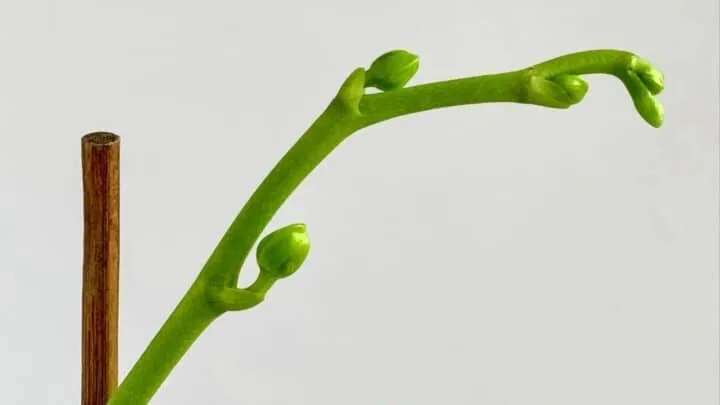While orchids are easy to maintain and generally resilient to bad weather, sometimes their stems may turn yellow.
Let us find out why this happens and discuss what you can do about it.
Table of Contents
Why Is My Orchid Stem Turning Yellow?
Orchid stems turn yellow due to overexposure to direct light, overwatering, normal aging, bacterial and fungal infections, and pests. But, if it’s only the part of the stem holding the bloom that has turned yellow, the flower spike is dying out.
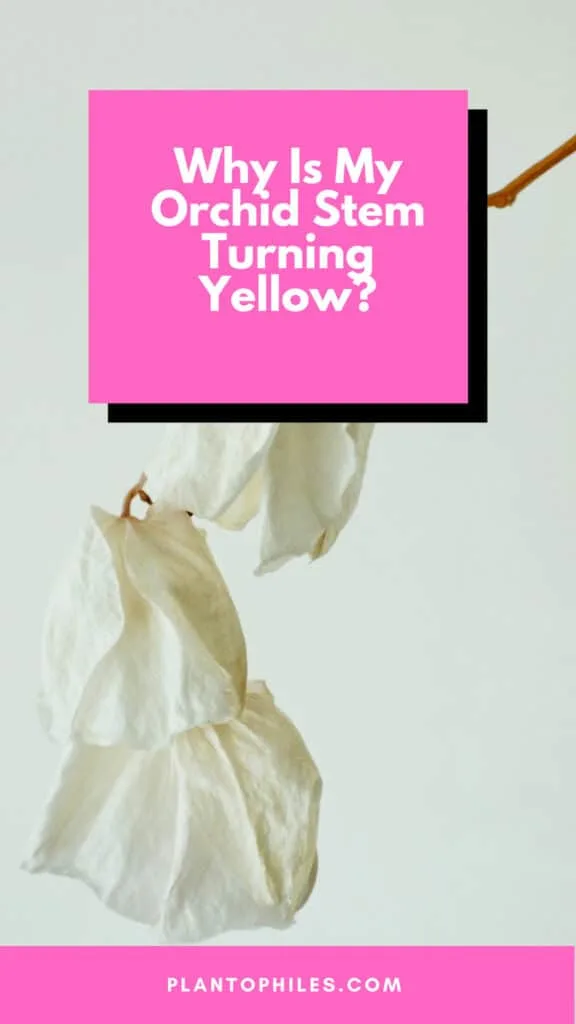
1. The Main Cause of Yellowing in Orchid Stems is Overexposure to Excess Light
In determining why orchid stems turn yellow, we should understand that most people use the term “stem” to refer to either the flower spike or the actual stem.
Under normal circumstances, green pigmentation signals good health in both.
For most plants, sunlight is essential to growth and healthy development.
It’s used in photosynthesis to produce food for the plant’s sustenance and growth.
Therefore, the general expectation is that the more plants stay exposed to light, the more food they make and the healthier they stay. However, this assumption does not hold up for orchids.
In most orchids like phalaenopsis, overexposure to direct light causes scorching. If this happens repeatedly, parts such as stems, spikes, and leaves gradually turn yellow.
Here’s why:
Orchids are tropical plants. They thrive well in the shade of large trees with deep canopies, allowing very little light to enter.
Therefore, they are not used to lengthy exposure to direct sunlight. Too much light triggers a burning effect, which eventually causes the yellowing of stems and spikes.
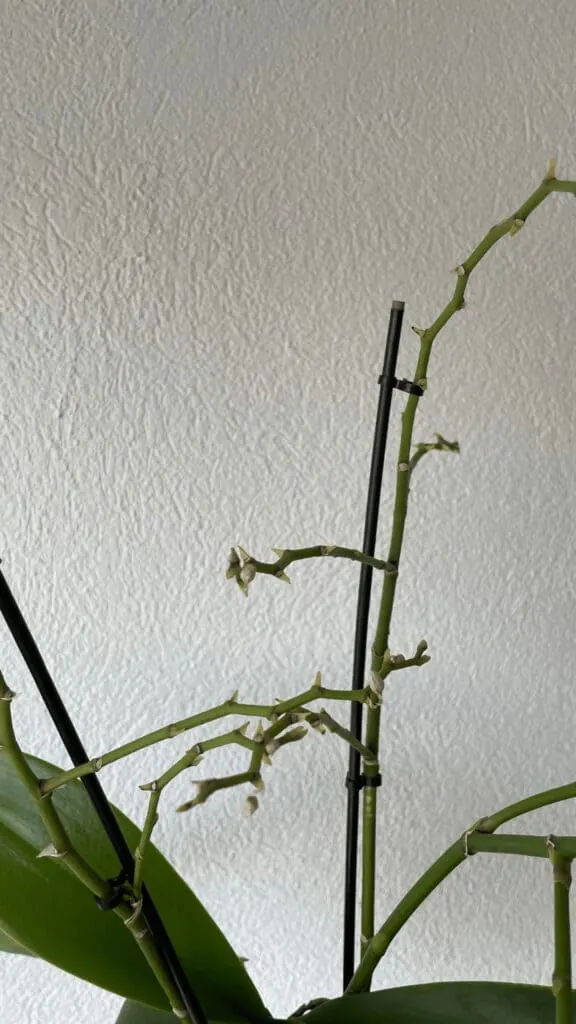
2. Moisture Stress
With houseplants, we should water them only as much as they need. Overwatering or underwatering can cause stems to turn yellow.
As soon as abnormal yellow pigmentations appear on orchids’ stems, we should first check the soil in their pots.
When orchids don’t get enough water, they instinctively shed their leaves to conserve their little water by minimizing transpiration.
As a result, the plants’ regular food production will be hindered. This causes stems, spikes, and other green parts to turn yellow or brown.
Too much water is just as dangerous as water deficiency. Poor soil drainage leads to water-logging around the orchids’ roots.
If this continues for a long time, the roots will drown, lack oxygen, and die. Again, this hinders food production, causing yellowing or discoloration of stems.
Related: How to water a phalaenopsis orchid.
3. Normal Aging
Aging can also cause the yellowing of orchid stems, especially spikes. As most orchids age, the tips beneath the bloom occasionally turn yellow.
This process is part of the plant’s natural cycle and should be no cause for alarm.
After some time, the spikes will dry up and drop off themselves. Alternatively, we can trim them back to the main stem.
Doing so promotes faster regrowth and rapid blooming.
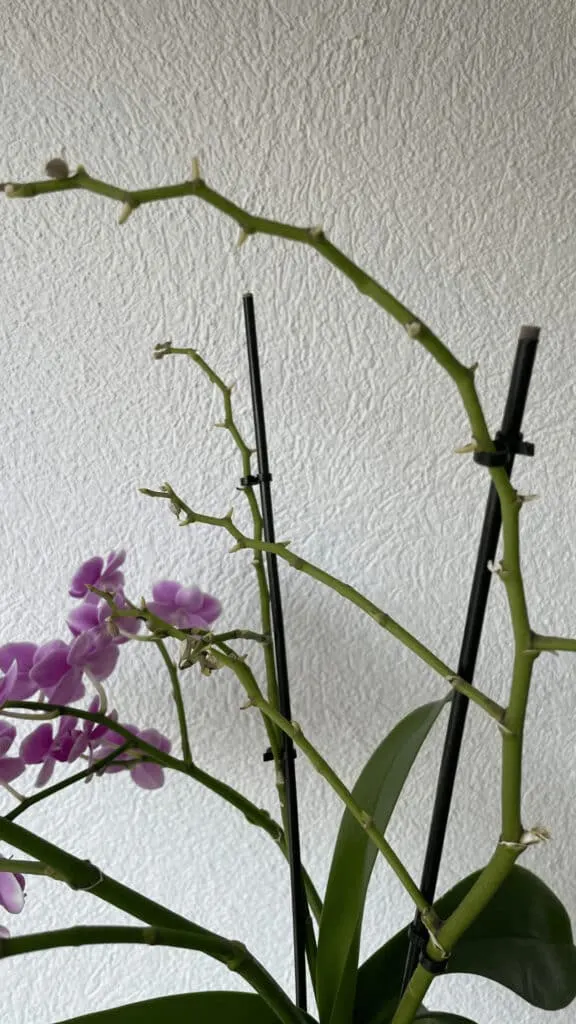
4. Nutrient Deficiency
Orchid stems may also turn yellow if the plant is not adequately receiving the right proportions of all the nutrients it requires.
The two most common nutrient deficiencies synonymous with the yellowing of orchid stems are excess calcium and inadequate nitrogen.
Different orchids require different nutrients. Before we uproot or kill any orchid due to a yellow stem, we should adequately research and diagnose the cause.
I recently acquired a soil kit for at-home soil tests, and it has significantly helped me identify my orchids’ nutritional needs and keep them healthy.
5. Fungal or Bacterial Infection
A healthy orchid is more resilient. When an orchid carries a fungal or bacterial infection, they are weakened and might lose spiker, flowers, and stems to save energy.
Some diseases that set on orchids are botrytis flower blighting, crown rot because of water sitting on leaves and stems for too long,
You can counter fungal infections using a fungicide such as a copper spray. The important thing is that it needs to be applied as fast as possible. Once the plant tissue is affected, it is very hard to get rid of a fungus, based on my experience.
Bacterial infections are even quicker to spread. They enter through wounds in the orchid and rot the tissue. According to the Orchid Society, a good remedy is hydrogen peroxide and copper fungicides.
6. Pests
I have battled pests on my houseplants since I started keeping houseplants 20 years ago. There is just no possible way to avoid this topic.
While my orchids usually are not very prone to aphids, thrips, scale, and fruit flies, I sometimes have issues with mealybugs.
Mealybugs are small white-looking insects that multiply quickly. They suck the plant sap and lead to the leaf. And stem yellowing. When they are small in numbers, they are easy to get rid of. However, once they multiply, they become problematic.
I usually pick them up by hand or use a towel to squish them. I also used Q-tips with rubbing alcohol, diluted dishwater soap, and neem oil with success. Anything that dissolves their bodies instantly once applied.
Effects of Orchid Stems Turning Yellow And Flowers Falling Off
Based on my experience and discussions with friends, here are some reasons why no houseplant owner would love their orchid stems to turn yellow:
- Yellowing of stems can cause demoralization. I remember blaming myself and trying to find out what I didn’t do right when my orchids’ stems first turned yellow. I had done everything—from adequate watering to proper lighting and regular soil testing—and continually wondered why all these efforts bore no fruits
- Yellow stems jeopardize the aesthetic appeal of orchids, which is one of the main reasons we grow these houseplants. The best orchids are those with green stems and colorful blooms.
- Yellow spikes can also hinder healthy blooming
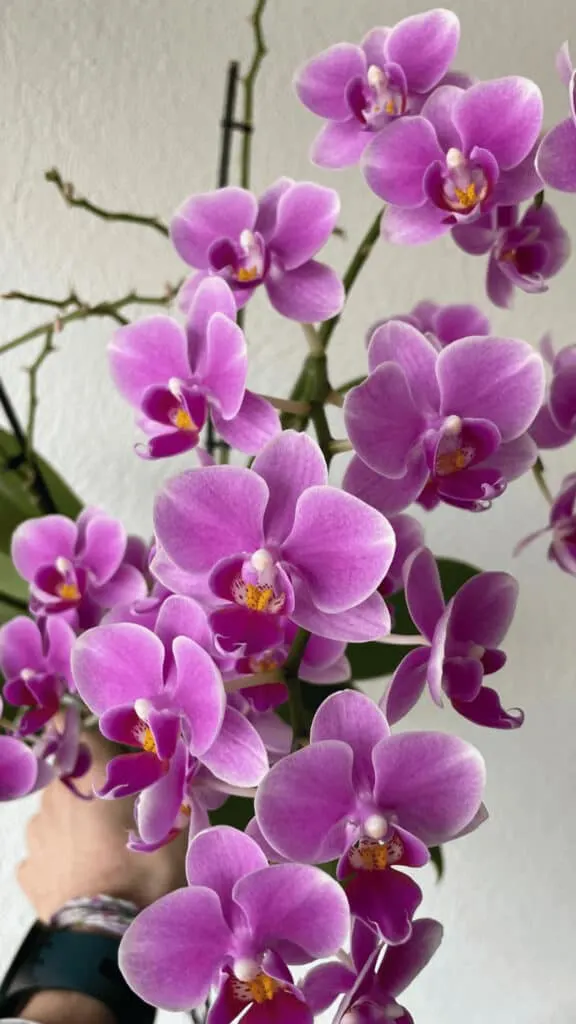
The Solution to Yellowing in Orchid Stems
As I have highlighted, the causes of yellowing in orchid stems differ. So, there’s no across-the-board solution.
Instead, we should examine each case, identify the problem, and implement the correct remedy.
Here are some possible solutions I may consider:
1. Adjust the Orchid’s Environment
Where the yellowing of the stem is due to overexposure to direct light, the solution is to move the plant to a different position with limited light reach.
Alternatively, you can use artificial light that is easily adjusted and controlled.
2. Use Clean Water
Excess calcium in the soil causes stem yellowing. In most cases, calcium-laden water introduces extra calcium into the soil.
So, using clean water is another way to prevent orchid stems from turning yellow.
3. Cut off the Yellow Spikes
As I pointed out, the yellowing of spikes indicates that they are done supporting life.
We can cut off the tips to eliminate the yellow pigmentation and encourage rapid regrowth.
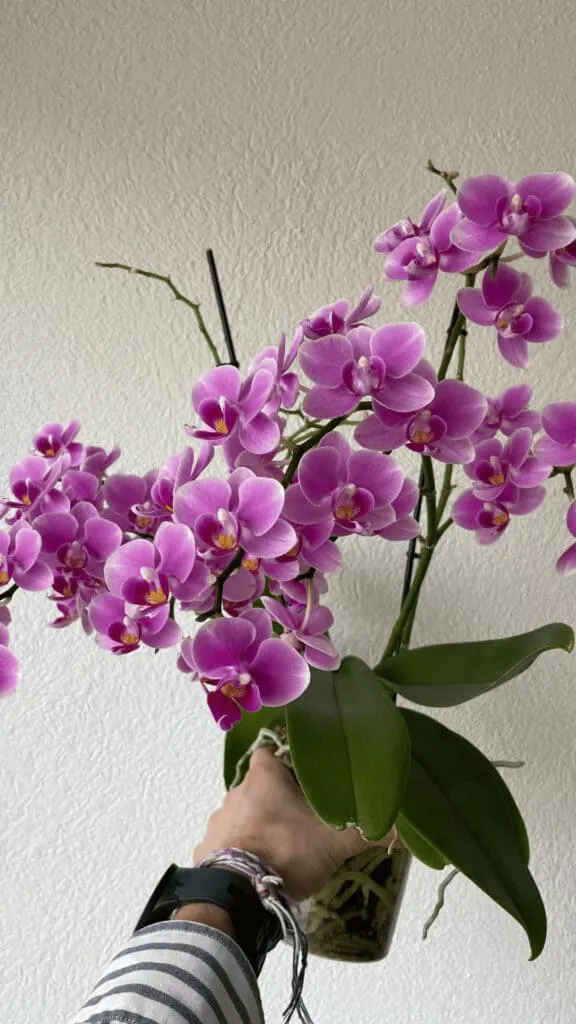
Frequently Asked Questions About Why My Orchid Stem Is Turning Yellow
How do I stimulate blooming in my orchid?
By putting it in a cold room, preferably by the window. When the sun sets, the heat will reduce, and the resulting cold will induce the orchid to bloom.
Should I cut off or uproot orchids with yellow stems?
Yellowing of stems is a common phenomenon in orchids. When it happens, we shouldn’t rush to kill the whole plant. Instead, only cut off the yellowed stems.
Why are orchid stems turning yellow and brown?
There are several reasons why orchid stems turn yellow and brown. It can be natural because of aging, water stress, too much light, nutrient deficiency or fungal or bacterial infection.
The Last Stem
These tips have helped me maintain and keep my orchids healthy.
We should note that it’s easier and better to prevent the yellowing of stems before it happens.
Otherwise, we may notice the change in pigmentation when it’s already too late.

Daniel has been a plant enthusiast for over 20 years. He owns hundreds of houseplants and prepares for the chili growing seasons yearly with great anticipation. His favorite plants are plant species in the Araceae family, such as Monstera, Philodendron, and Anthurium. He also loves gardening and is growing hot peppers, tomatoes, and many more vegetables.

